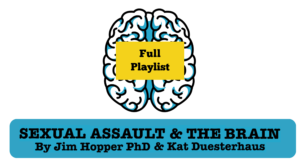Available in English, Spanish and German, with other languages coming.
Why don’t many people fight or escape when they’re being raped?
Why are memories of sexual assault so often fragmentary and lacking a clear linear narrative?
Is the brain’s response to attack essentially the same – controlled by the defense circuitry, running on reflexes and habits – during sexual assault, physical assault, and military combat?
The answers have big implications for people who have been sexually assaulted, for those who investigate and prosecute such crimes, and for everyone else who knows or works with someone who’s been sexually assaulted.
The answers, it turns out, are the same in every culture. Around the world, the most common responses of people during sexual assaults are basically the same: The brain’s defense circuitry takes over, the rational prefrontal cortex is impaired, and behavior is mostly reflexive and habitual.
Evolution sculpted those basic responses into our brains long before we were sophisticated enough to create cultures, long before we began to misunderstand and misjudge sexual assault survivors with culture-based expectations of how women and men “should” respond during assaults and remember them later.
The impacts of stress and trauma on the brain’s “hardware” have always and everywhere been the same. That includes giving control of behavior mostly to the habit circuitry. But the “software” that runs on the habit circuitry has been created and shaped by experience and by culture. That software consists of habitual ways that assault victims have already been conditioned – including by power relations based on sex, class, age, race, ethnicity, gender, sexuality, etc. – into passive resistance and submission to those who possess more power than them.
This is why most sexual assault victims find themselves automatically engaging in – and stuck on – ineffective passive and submissive habit behaviors. The neurobiology of stress and trauma intersect with power dynamics and culturally conditioned habits. This also explains why most perpetrators select their victims based on those power differentials, and why they can generally depend on victims’ ineffective resistance and submission.
Critically, these are also reasons why using “fight, flight, freeze” – and adding more f-words (e.g., flop, fawn) as many are now doing – should be abandoned. No phrase starting with “fight, flight, freeze” will reflect the reality of most behaviors of most victims, especially habits of passive resistance and submission that clearly are not “fawning.”
No catchy collection of f-words will reflect what’s known about the neurobiology of trauma. Anything that starts with “fight, flight” and fails to point to habit behaviors (and their roots in culture and power) will be incomplete, even be harmful.
That’s why I’ve been advocating that we all – especially professionals working with people who’ve been sexually assaulted – understand victim’s responses during sexual assaults in terms of “survival mode” and “reflexes and habits.” I regularly teach these things as a consultant and trainer. Here on my website, I provide lots of free videos, writings, and handouts.



